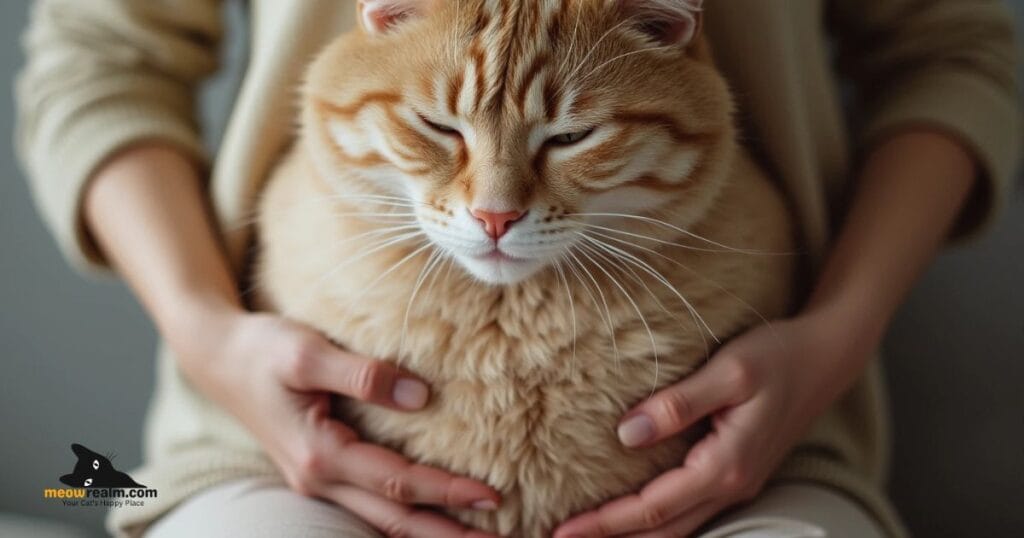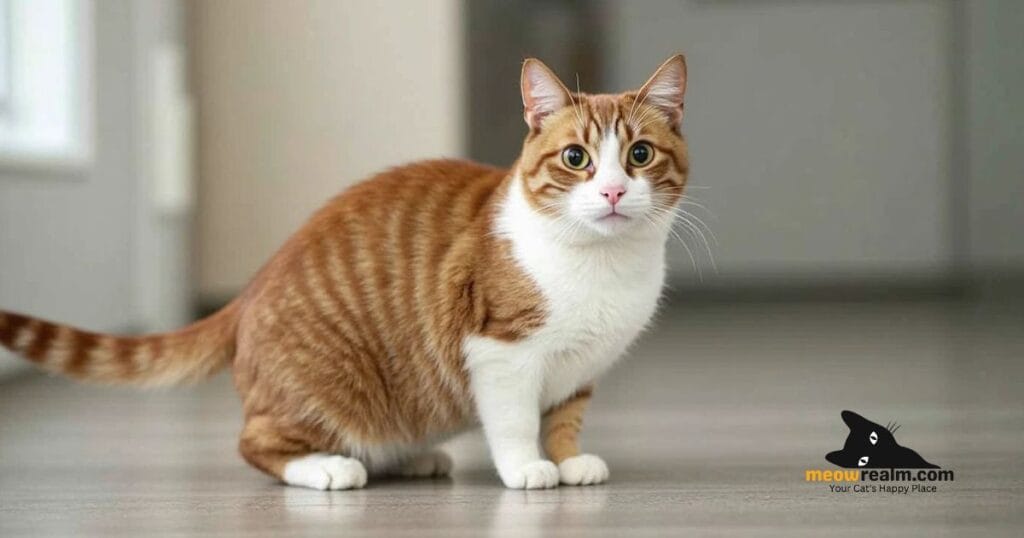cat pregnant belly – The moment you notice your beloved cat showing signs of pregnancy, there’s a sense of excitement and anticipation. Caring for a pregnant cat brings responsibility and the joy of watching new lives grow. Observing your cat’s pregnant belly can tell you a lot about her health and how her pregnancy is progressing. In this guide, you’ll learn everything from the early signs of pregnancy to the best ways to care for your cat and prepare for the arrival of her kittens.
By understanding the changes in your cat’s pregnant belly, you’re not just a passive observer—you’re an active participant in ensuring a safe, healthy pregnancy. Whether this is your first time caring for a pregnant cat or you’re looking to learn more, this comprehensive guide is here to help you every step of the way.
Table of Contents
Signs of a Cat’s Pregnant Belly– cat pregnant belly

When to Notice Changes
Your cat’s pregnancy, known as gestation, typically lasts around 63-65 days. Visible changes in her belly usually become noticeable by the third week. Recognizing these changes early on is essential for providing the best care possible.
Physical Signs of a Cat’s Pregnant Belly
- Belly Growth: One of the most apparent signs is the gradual enlargement of your cat’s belly. By weeks four and five, her abdomen should be noticeably rounder.
- “Pinking Up”: Another early indicator is “pinking up,” when your cat’s nipples become pinker and slightly enlarged. This happens around two to three weeks into pregnancy.
- Increased Appetite and Weight Gain: Expect your cat to show a greater appetite as her body adjusts to nourish the growing kittens.
Behavioral Changes in Pregnant Cats
Behavioral shifts often accompany physical changes. You may notice your cat becoming more affectionate, displaying increased purring, or starting to seek cozy places to nest. These behaviors reflect her instinct to prepare for the arrival of her kittens. Paying attention to these signs can help you anticipate her needs and offer a comforting environment.
How to Care for Your Cat’s Pregnant Belly – cat pregnant belly
Providing care that supports your cat’s health and comfort during pregnancy is key. Here’s a breakdown of essential care practices to ensure she and her kittens thrive.
Diet and Nutrition
Proper nutrition is a cornerstone of pregnancy care. During this time, your cat will require a balanced, nutrient-rich diet to support her health and the growth of her kittens. Many veterinarians recommend high-quality kitten food for pregnant cats because it is designed to meet the needs of both the mother and her kittens.
- Balanced Diet: Opt for a diet rich in protein, fats, and essential vitamins. This can support her increased energy needs and help maintain a healthy weight.
- Feeding Schedule: Offer smaller, frequent meals to prevent overeating and aid in digestion. As her belly grows, eating large portions might become uncomfortable, so frequent meals can help ease digestion.
Safe Exercise and Play
Though your cat may become less active as her belly grows, gentle exercise is beneficial. Encourage light play sessions, but avoid any strenuous activity or activities that could lead to injury.
- Gentle Movements: Interactive toys can stimulate mental engagement without straining her physically.
- Avoid High Places: Try to prevent climbing or jumping from high surfaces, as these could lead to falls and injury.
Preparing a Nesting Area
As her due date approaches, your cat will likely begin “nesting.” Setting up a comfortable, safe space will provide her with a secure area when she’s ready to give birth.
- Cozy Bedding: Use soft blankets or towels to line a box or crate. This will help keep her comfortable and warm.
- Quiet, Private Area: Place the nesting box in a quiet room away from other pets or disturbances. Privacy during labor is crucial, as cats often seek secluded spaces.
When a Cat’s Pregnant Belly is a Concern – cat pregnant belly

While most pregnancies progress smoothly, knowing when to consult a veterinarian is essential. Identifying potential issues early can prevent complications.
Unusual Symptoms to Watch For
Stay vigilant for symptoms that deviate from the norm, as they could signal health issues:
- Excessive Weight Gain: If your cat’s weight gain seems rapid or excessive, it could indicate an underlying health issue. Consult your vet if you notice sudden changes.
- Lethargy or Vomiting: These can be signs of illness, especially if they persist. Occasional vomiting might be normal, but regular episodes warrant a check-up.
Common Pregnancy Complications
While pregnancy complications are uncommon, understanding potential risks can help you act quickly if needed:
- Dystocia: Difficult labor, or dystocia, occurs when a cat has trouble delivering her kittens. Signs include excessive straining without progress, prolonged labor, or visible distress. Veterinary intervention may be required to ensure the safety of both the mother and her kittens.
- Pre-Eclampsia: This rare condition causes calcium deficiencies in pregnant cats, leading to muscle tremors or even seizures. If your cat displays signs of muscle weakness or tremors, seek veterinary assistance immediately.
Regular Vet Visits and Ultrasounds
Routine vet check-ups are invaluable for monitoring your cat’s pregnancy. An ultrasound can confirm pregnancy and allow you to track the kittens’ development. Routine check-ups also enable early detection of any complications, so you’re prepared for a smooth delivery.
Preparing for Labor – cat pregnant belly
As the due date nears, preparing for labor can help you support your cat through this transformative experience.
Labor Signs in Cats
What to Expect When Your Cat Goes into Labor
Labor generally has three stages:
- Initial Contractions: The cat may become restless, panting, and moving in and out of her nesting area.
- Delivery of Kittens: Contractions increase, and kittens are usually delivered with intervals in between.
- Afterbirth: After each kitten is born, the placenta follows. Ensure the mother cat expels each placenta to avoid complications.
How to Support Your Cat During Labor
Offer a calm, reassuring presence nearby, but avoid excessive intervention unless necessary. Provide water and a comfortable environment, but respect her need for privacy. If labor lasts over six hours without progress, consult your vet.
Pros and Cons of Caring for a Pregnant Cat -cat pregnant belly
Pros-cat pregnant belly
- Bonding Opportunity: Pregnancy brings you closer to your cat as you support her through each stage.
- Joy of New Life: Watching kittens develop and thrive is a unique experience filled with wonder.
- Enhanced Understanding of Feline Care: Caring for a pregnant cat offers insights into feline health and behavior, deepening your connection to her.
Cons -cat pregnant belly
- Higher Costs: Caring for a pregnant cat includes added costs for vet visits, special diets, and potential emergencies.
- Increased Responsibility: Pregnancy requires extra time, attention, and patience, especially when preparing for labor and caring for kittens post-birth.
- Stress and Complications: While fulfilling, pregnancy can be stressful for both you and your cat if complications arise.
FAQ Section

- How can I tell if my cat’s belly is pregnant or just fat?
- Pregnancy often involves belly growth, but you may also notice behavior changes and “pinking up” of the nipples. If you’re unsure, a vet can confirm through an exam or ultrasound.
- Is it safe to touch my cat’s pregnant belly?
- Gentle handling is usually safe, but it’s best to avoid applying pressure. If she shows discomfort, refrain from touching her belly.
- How long is the gestation period for a cat?
- Cats are typically pregnant for around 63-65 days. Tracking her pregnancy from the suspected conception date can help you prepare.
- What should I feed my cat when she’s pregnant?
- High-quality kitten food provides essential nutrients for both mother and kittens. Consult your vet for specific recommendations based on her health and dietary needs.
Conclusion
Caring for a cat’s pregnant belly is both a joy and a commitment. By staying informed and vigilant, you’re ensuring a healthy pregnancy and creating a safe environment for the arrival of her kittens. Providing comfort, support, and nutrition during this critical time will foster a strong bond and a happy, healthy family of kittens.
For more guides on cat care and pregnancy support, explore www.meowrealm.com. And if you know someone who would benefit from this guide, feel free to share it to help others learn about the joys and responsibilities of caring for a pregnant cat.

